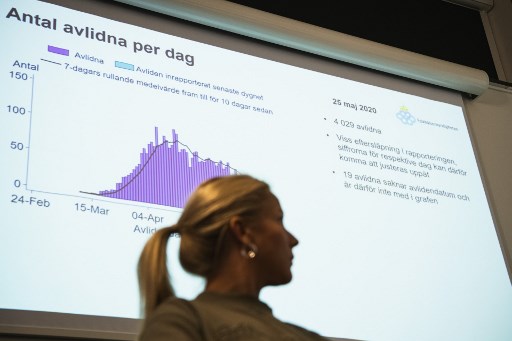Covid-19 deaths top 4,000 in under-fire Sweden
Sweden’s death toll has far surpassed the tolls in neighbouring Nordic countries, which have all imposed more restrictive containment measures.
by AFPA journalist is seen in front of a screen as the Swedish Public Health Agency releases the new total number of people who died due to the Covid-19 coronavirus, during a press conference to update on the situation on May 25, 2020 in Solna near Stockholm, Sweden. Picture: Jonathan NACKSTRAND / AFP
Sweden, which has gained international attention for its softer approach to the coronavirus than many of its European neighbours, said on Monday its number of deaths passed the 4,000 mark.
The Public Health Agency said it had recorded 4,029 deaths and 33,843 confirmed cases of the novel coronavirus in the country of some 10.3 million inhabitants, with 90 percent of the deceased over the age of 70.
Sweden’s death toll has far surpassed the tolls in neighbouring Nordic countries, which have all imposed more restrictive containment measures.
According to AFP’s own database, Sweden’s virus death rate of 399 per million inhabitants is far higher than Norway’s 43 per million, Denmark’s 97, or Finland’s 55.
However it is still lower than for France at 435 per million, Britain and Italy, both at 542, and Spain at 615.
Critics have accused Swedish authorities of gambling with citizens’ lives by not imposing strict stay-at-home measures. But the Public Health Agency has insisted its approach is sustainable in the long-term and has rejected drastic short-term measures as too ineffective to justify their impact on society.
The Scandinavian country has kept schools open for children under the age of 16, along with cafes, bars, restaurants and businesses, while urging people to respect social distancing and hygiene guidelines.
State epidemiologist Anders Tegnell of the Public Health Agency stressed countries’ death tolls should be compared with caution.
“In Sweden, anybody who has the diagnosis of Covid-19 and dies within 30 days after that is called a Covid-19 case, irrespective of the actual cause of death. And we know that in many other countries there are other ways of counting that are used,” he told AFP.
Tegnell has repeatedly insisted that stricter measures would not have saved more Swedish lives.
Three-quarters of those who have died have been either in nursing homes or receiving at-home care.
Tegnell noted that a ban on visits to nursing homes was introduced in mid-March, but said elderly residents needed regular contact with their carers — who were believed to have spread the virus around many nursing homes.
“I’m really not sure that we could have done so much more,” he said in a weekend interview with Swedish Radio, acknowledging nonetheless that the country had ended up in a “terrible situation that highlights the weaknesses of our elderly care.”
He said care homes had initially failed to respect basic hygiene rules that could have curbed the spread of the disease, but said the situation had since improved.
The Board of Health and Welfare meanwhile insisted Sweden’s nursing homes were functioning well.
It noted that a total of 11,000 nursing home residents died in January-April this year, compared with 10,000 during the same period a year ago.
And Tegnell told reporters on Monday that the overall situation in Sweden “was getting better,” with a declining number of people being admitted to intensive care units, a drop in the number of cases being reported in nursing homes, and fewer deaths in nursing homes.
